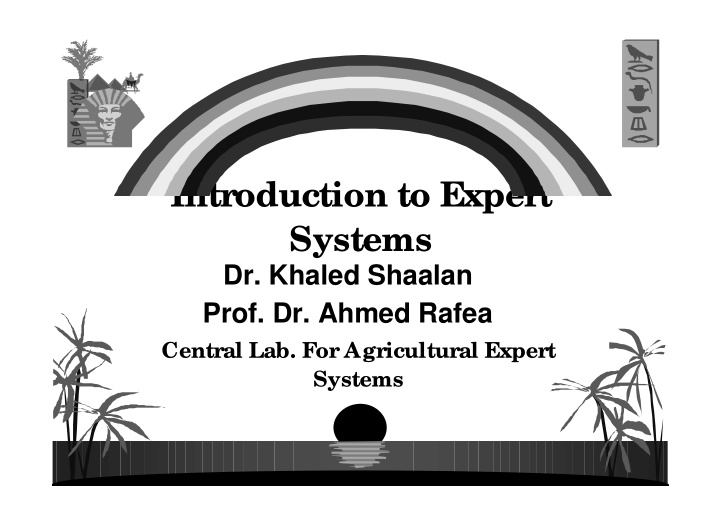



Introduction to Expert Introduction to Expert Systems Systems Dr. Khaled Shaalan Prof. Dr. Ahmed Rafea Central Lab. For Agricultural Expert Central Lab. For Agricultural Expert Systems Systems
Topics • What is AI ? • What is KBS? • What is expert system? • The structure of an expert system • Characteristics of an expert system • When are expert systems useful? • The players in the expert system game • Evolution of expert systems
What is AI? ARTIFICIAL INTELLIGENCE (AI) IS A BRANCH OF COMPUTER SCIENCE THAT IS STUDYING HOW TO LET COMPUTERS PERFORM FUNCTIONS CONSIDERED TO BE HIGH LEVEL HUMAN ACTIVITIES
What is KBS? A KNOWLEDGE - BASED SYSTEM (KBS) IS A COMPUTER PROGRAM THAT USES KNOWLEDGE AND PROBLEM SOLVING TECHNIQUES
What is expert system? AN EXPERT SYSTEM (ES) IS A COMPUTER PROGRAM DESIGNED TO SIMULATE THE PROBLEM- SOLVING BEHAVIOR OF AN EXPERT IN A NARROW DOMAIN OR DISCIPLINE.
What is expert system?(cont.) Exhibit intelligent ARTIFICIAL behavior by skillful INTELLIGENCE application of heuristics PROGRAMS KNOWLEDGE-BASED SYSTEMS make domain knowledge explicit and separate from the rest of the system EXPERT Apply expert knowledge SYSTEMS to difficult, real world problems
The structure of an expert system Organizing Knowledge EXPERT SYSTEM KNOWLEDGE BASE Domain Knowledge FACTS RULES INTERPRETER SCHEDULER INFERENCE ENGINE General problem-solving knowledge
Representing knowledge � Rule-based methods � Frame-based methods
Rules � A rule is a formal way of specifying a recommendation, directive, or advice � A rule is expressed as IF IF premise premise THEN THEN conclusion conclusion or IF condition condition THEN THEN action action IF
A diagnostic rule IF there are spots on leaves, and IF the color of spots is pale yellow, gray, or purple, and the shape of spots is bounded making acute angle with veins, and the season is spring Then the disease is downy mildew - Then probability = 0.9
A treatment rule IF the disease is downy mildew IF THEN the treatment method is chemical THEN spraying, and the material used is redomil+copper
Drawing inferences from rules � Forward chaining � Backward chaining
Frames � A frame is a description of an object that contains slots for all of the information associated with the object � Slots may contain (default) values, or procedures by which values may be obtained
Soil Frame Slots Facets Ph value type: real single/multiple: single possible value: > 0.0 & 14.0 EC value type: real single/multiple: single possible value: > 0.0 Texture value type: nominal single/multiple: single possible value: sand, loam, clay, heavy clay, gravely, coarse sand, silty clay, silty clay loam, salt loam, fine sand, sand clay loam, silt loam, sandy loam, loamy fine sand … …
Disorder hierarchy Frames connected by IS-A relation Disorder generic Disease Mites Environmental Insect Nutrition Deficiency Toxicity Nematode Fungal Spiders Low temperature aphids Nitrogen Bromide Root knot Broad mite Heavy irrigation Iron Bazamide Root lesion Leaf mold Downy mildew Viral Mosaic Green Mosaic specialized
Drawing inferences from frames � Inheritance � Procedure attachment
Characteristics of an expert system Expert System Exhibit expert performance Have high level of skill Expertise Have adequate robustness Represent knowledge symbolically Symbolic reasoning Reformulate symbolic knowledge Handle difficult problem domains Depth Use complex rules Examine its own reasoning Self-knowledge Explain its operation
When are expert systems useful? � Nature of the task – Experts can do better than nonexperts – The task involves reasoning and knowledge, not intuitions or reflexes – The task can be done by a person in minutes or hours – The task is concrete enough to codify – The task is commonly taught to novices in the area
When are expert systems useful? (Cont.) � Availability of knowledge – Recognized experts exist – There is general agreement among experts – Experts are able and willing to articulate the way they approach problems
The players in the expert system game Domain Tool builder Extends expert and test Builds Interviews EXPERT Knowledge EXPERT End-user SYSTEM engineer SYSTEM BUILDING Uses Uses Builds TOOL refines and tests Clerical Staff
Expert system building tool � Programming language � Shell
Shells VS Programming languages Features Shells Prog. Lang. Higher Less Ease & speed of development Restricted by May be developed KB Structure &reasoning the tool As needed Easier Difficult KB maintenance
Shells VS Programming languages (Cont.) Features Shells Prog. Lang. Interfaces Not always Have to be friendly or developed available Slower Faster Efficiency/ Performance Explanation Restricted by May be developed the tool as needed
Evolution of expert systems Development Stage Description Demonstration The system solves a portion of the problem Prototype undertaken, suggesting that the approach is viable and system development is achievable. (test ideas) Research The system displays credible performance on the prototype entire problem but may be fragile due to incomplete testing and revision. (test cases) Field prototype The system displays good performance with adequate reliability and has been revised based on extensive testing in the user environment. (test real problems) Production model The system exhibits high quality, reliable, fast, and efficient performance in the user environment. (extensive field tests) Commercial The system is a production model being used on a system regular commercial basis.
Recommend
More recommend